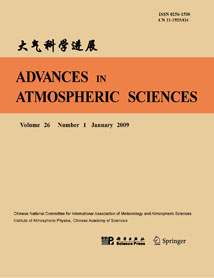| [1] |
Chang-Hoi HO, Joo-Hong KIM, Hyeong-Seog KIM, Woosuk CHOI, Min-Hee LEE, Hee-Dong YOO, Tae-Ryong KIM, Sangwook PARK,
2013: Technical Note on a Track-pattern-based Model for Predicting Seasonal Tropical Cyclone Activity over the Western North Pacific, ADVANCES IN ATMOSPHERIC SCIENCES, 30, 1260-1274.
doi: 10.1007/s00376-013-2237-6
|
| [2] |
MA Zhanhong, FEI Jianfang, HUANG Xiaogang, CHENG Xiaoping,
2014: Impacts of the Lowest Model Level Height on Tropical Cyclone Intensity and Structure, ADVANCES IN ATMOSPHERIC SCIENCES, 31, 421-434.
doi: 10.1007/s00376-013-3044-9
|
| [3] |
LIU Zhengyu, WU Shu, ZHANG Shaoqing, LIU Yun, RONG Xinyao, ,
2013: Ensemble Data Assimilation in a Simple Coupled Climate Model: The Role of Ocean-Atmosphere Interaction, ADVANCES IN ATMOSPHERIC SCIENCES, 30, 1235-1248.
doi: 10.1007/s00376-013-2268-z
|
| [4] |
HUANG Hong, JIANG Yongqiang, CHEN Zhongyi, LUO Jian, WANG Xuezhong,
2014: Effect of Tropical Cyclone Intensity and Instability on the Evolution of Spiral Bands, ADVANCES IN ATMOSPHERIC SCIENCES, 31, 1090-1100.
doi: 10.1007/s00376-014-3108-5
|
| [5] |
QIN Xiaohao, MU Mu,
2014: Can Adaptive Observations Improve Tropical Cyclone Intensity Forecasts?, ADVANCES IN ATMOSPHERIC SCIENCES, 31, 252-262.
doi: 10.1007/s00376-013-3008-0
|
| [6] |
FU Weiwei, ZHOU Guangqing, WANG Huijun,
2006: Modeling the Tropical Pacific Ocean Using a Regional Coupled Climate Model, ADVANCES IN ATMOSPHERIC SCIENCES, 23, 625-638.
doi: 10.1007/s00376-006-0625-x
|
| [7] |
XU Yamei,
2011: The Genesis of Tropical Cyclone Bilis (2000) Associated with Cross-equatorial Surges, ADVANCES IN ATMOSPHERIC SCIENCES, 28, 665-681.
doi: 10.1007/s00376-010-9142-z
|
| [8] |
Feifan ZHOU, Wansuo DUAN, He ZHANG, Munehiko YAMAGUCHI,
2018: Possible Sources of Forecast Errors Generated by the Global/Regional Assimilation and Prediction System for Landfalling Tropical Cyclones. Part II: Model Uncertainty, ADVANCES IN ATMOSPHERIC SCIENCES, 35, 1277-1290.
doi: 10.1007/s00376-018-7095-9
|
| [9] |
LIAO Zhijie, ZHANG Yaocun,
2013: Simulation of a Persistent Snow Storm over Southern China with a Regional Atmosphere-Ocean Coupled Model, ADVANCES IN ATMOSPHERIC SCIENCES, 30, 425-447.
doi: 10.1007/s00376-012-2098-4
|
| [10] |
Zeng Qingcun, Dai Yongjiu, Xue Feng,
1998: Simulation of the Asian Monsoon by IAP AGCM Coupled with an Advanced Land Surface Model (IAP94), ADVANCES IN ATMOSPHERIC SCIENCES, 15, 1-16.
doi: 10.1007/s00376-998-0013-9
|
| [11] |
Shuwen ZHAO, Yongqiang YU, Pengfei LIN, Hailong LIU, Bian HE, Qing BAO, Yuyang GUO, Lijuan HUA, Kangjun CHEN, Xiaowei WANG,
2021: Datasets for the CMIP6 Scenario Model Intercomparison Project (ScenarioMIP) Simulations with the Coupled Model CAS FGOALS-f3-L, ADVANCES IN ATMOSPHERIC SCIENCES, 38, 329-339.
doi: 10.1007/s00376-020-0112-9
|
| [12] |
Chang LIU, Shaoqing ZHANG, Shan LI, Zhengyu LIU,
2017: Impact of the Time Scale of Model Sensitivity Response on Coupled Model Parameter Estimation, ADVANCES IN ATMOSPHERIC SCIENCES, 34, 1346-1357.
doi: 10.1007/s00376-017-6272-6
|
| [13] |
Yu Yongqiang, Yu Rucong, Zhang Xuehong, Liu Hailong,
2002: A Flexible Coupled Ocean-Atmosphere General Circulation Model, ADVANCES IN ATMOSPHERIC SCIENCES, 19, 169-190.
doi: 10.1007/s00376-002-0042-8
|
| [14] |
LIU Xiying, ZHANG Xuehong, YU Yongqiang, YU Rucong,
2004: Mean Climatic Characteristics in High Northern Latitudes in an Ocean-Sea Ice-Atmosphere Coupled Model, ADVANCES IN ATMOSPHERIC SCIENCES, 21, 236-244.
doi: 10.1007/BF02915710
|
| [15] |
ZHENG Weipeng, YU Yongqiang,
2007: ENSO Phase-Locking in an Ocean-tmosphere Coupled Model FGCM-1.0, ADVANCES IN ATMOSPHERIC SCIENCES, 24, 833-844.
doi: 10.1007/s00376-007-0833-z
|
| [16] |
Dai Yongjiu, Xue Feng, Zeng Qingcun,
1998: A Land Surface Model (IAP94) for Climate Studies Part II: Implementation and Preliminary Results of Coupled Model with IAP GCM, ADVANCES IN ATMOSPHERIC SCIENCES, 15, 47-62.
doi: 10.1007/s00376-998-0017-5
|
| [17] |
Xinrong WU, Shaoqing ZHANG, Zhengyu LIU,
2016: Implementation of a One-Dimensional Enthalpy Sea-Ice Model in a Simple Pycnocline Prediction Model for Sea-Ice Data Assimilation Studies, ADVANCES IN ATMOSPHERIC SCIENCES, 33, 193-207.
doi: 10.1007/s00376-015-5099-2
|
| [18] |
LI Chaofan, LIN Zhongda,
2015: Predictability of the Summer East Asian Upper-Tropospheric Westerly Jet in ENSEMBLES Multi-Model Forecasts, ADVANCES IN ATMOSPHERIC SCIENCES, 32, 1669-1682.
doi: 10.1007/s00376-015-5057-z
|
| [19] |
Yuyang GUO, Yongqiang YU, Pengfei LIN, Hailong LIU, Bian HE, Qing BAO, Shuwen ZHAO, Xiaowei WANG,
2020: Overview of the CMIP6 Historical Experiment Datasets with the Climate System Model CAS FGOALS-f3-L, ADVANCES IN ATMOSPHERIC SCIENCES, 37, 1057-1066.
doi: 10.1007/s00376-020-2004-4
|
| [20] |
Bo AN, Yongqiang YU, Qing BAO, Bian HE, Jinxiao LI, Yihua LUAN, Kangjun CHEN, Weipeng ZHENG,
2022: CAS FGOALS-f3-H Dataset for the High-Resolution Model Intercomparison Project (HighResMIP) Tier 2, ADVANCES IN ATMOSPHERIC SCIENCES, 39, 1873-1884.
doi: 10.1007/s00376-022-2030-5
|















 AAS Website
AAS Website 
 AAS WeChat
AAS WeChat 
 DownLoad:
DownLoad: